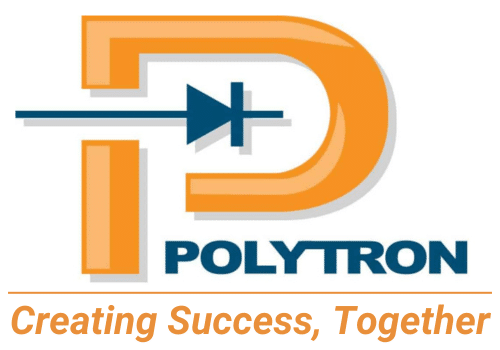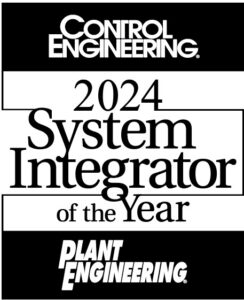Drives installed less than 7 years prior were moving to the end of their life cycle and were soon to be obsolete with no viable replacement from the supplier.
A fortune 100 CPG manufacturer needed to find a solution to replace all drives in their distribution center that provides consumer products to most commercial and residential customers across the Northeast U.S.
To manage cost, a new design called “Drive-In-A-Box” was created in the existing distributed drive configuration with the drive mounted on the side of the conveyors to avoid rewiring all of the power, controls, and communications to devices. By project completion, risk of major downtime was reduced, the communication protocol was updated and program logic was standardized.
Challenge |
Solution |
Results |
| Recently installed drives were soon to be obsolete with no viable replacement from the supplier | Create a new component in the existing distributed drive configuration with the drive mounted on the side of the conveyors
Install drives in conveyor sections to prevent shutting down converting equipment Update existing code to simplify programming structure |
Risk of major downtime was reduced
Communication protocol was updated Program logic was standardized and program structure was simplified for easier troubleshooting and drive functionality |
The Project
 Long-Term Drive Replacement Challenges
Long-Term Drive Replacement Challenges
When the Electrical Technical Engineer, responsible for technical support and operations at a fortune 100 CPG manufacturing distribution center, learned that their variable speed drives installed across the entire distribution center would soon be obsolete, he knew he needed to act fast.
Unfortunately, the manufacturer’s drives installed less than 7 years prior were moving to the end of their life cycle in manufacture and support.
Since the manufacturer had recently implemented the large capital project to reconfigure their distribution center with over 270 of the drives, the company was adverse to another large capital outlay. However, the distribution center provides consumer products to most of its commercial and residential customers across the Northeast U.S.
With no viable replacement from the supplier, the lead engineer was left to determine how he would find a long-term solution for replacing all drives in the distribution center.
Establishing a Plan for the Drive Replacement
The lead engineer reached out to long-time partner, Polytron, to start a study and brainstorm to form a logical long-term solution. Polytron’s history of implementing successful projects with the manufacturer in the past created the trust necessary for Polytron to take on the drive replacement project.
Polytron knew this project was a race against time to providing a solution for the current drives while also establishing a game plan of when downtime could be taken to implement the solution. Polytron started by conducting an Engineering Design Review (EDR) to determine solution options and the associated cost of replacing the drives.
Vested Interest in Using Supplier Products
The manufacturer had a vested interest in continuing with the supplier’s products, so Polytron worked with the supplier and a local electrical supplier to design a distributed drive package solution that would be a feasible solution for the distribution center conveying network.
Creating a Long-Term Sustainability Plan for the Distribution Center
In order to manage cost, the design would need to be in the existing distributed drive configuration with the drive mounted on the side of the conveyors to avoid rewiring all of the power, controls and communications to devices.
- A new design called “Drive-In-A-Box” was created to mount on the side of the conveyor and delivering reasonable life expectancy for the future
- The new drive provided the similar programming nomenclature as the previous drives for efficiency of the design and ease of software updates
- Additional design criteria included an update of the distribution center’s industrial control network configuration to upgrade to current manufacturer standards
- Polytron updated existing code to simplify programming structure for easier troubleshooting and to maximize drive functionality
- Within three years, nearly 270 drives had been replaced in the distribution center
- Installation for conveyor sections were broken to down to one (1) week increments from start to finish. This utilized alternate product path flow in order to prevent shutting down converting equipment.
- The spare drives were stockpiled to use as replacements if needed across the execution of the project timeline.
2020 Unexpected Project Challenge
When the COVID-19 pandemic started, the manufacturer and the Polytron team abided by CDC guidelines and postponed the installation of the 20-30 remaining drives.
Fortunately, with the prior upgrades the manufacturer had a large stockpile of the previous drives, and they could be used to replace any of failed drives until upgrades were complete. The stockpile lowered the risk associated with one of drives going down and better positioned the manufacturer to meet the increased CPG demand caused by the pandemic.
Handing Over the Project to a New Department Resource
The lead engineer was heavily engaged and committed to replacing the drives for his company, and he was confident that the project was at an appropriate level of capitalization. He had deep trust that the Polytron team would successfully implement the plan to completion. The engineer was retiring prior to the final stages of the project and was comfortable handing over the project to a new department resource for last drive replacements.
Successful Implementation of Drive-In-A-Box
The new electrical technical engineer worked with Polytron to successfully install the drives. It was important to take advantage of the programming effort to simplify the program structure where appropriate for easier troubleshooting and drive functionality when replacing the drives.
The distribution center’s Ethernet Controls network was updated along with the new drive installation. By the completion of the drive replacement project, risk of major downtime was reduced, the communication protocol was updated and program logic was standardized.




